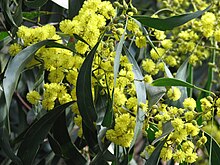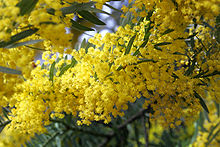Acacia is a genus of shrubs and trees belonging to the subfamily Mimosoideae of the family Fabaceae, first described in Africa by the Swedish botanist Carl Linnaeus in 1773. Many non-Australian species tend to be thorny, whereas the majority of Australian acacias are not. They are pod-bearing, with sap and leaves typically bearing large amounts of tannins and condensed tannins that historically in many species found use as pharmaceuticals and preservatives.
.jpg/170px-Acacia_saligna(03).jpg) The generic name derives from ακακία (akakia), the name given by early Greek botanist-physician Pedanius Dioscorides (ca. 40-90) to the medicinal tree A. nilotica in his book Materia Medica. This name derives from the Greek word for its characteristic thorns, ακις (akis, thorn). The species name nilotica was given by Linnaeus from this tree's best-known range along the Nile river.
The generic name derives from ακακία (akakia), the name given by early Greek botanist-physician Pedanius Dioscorides (ca. 40-90) to the medicinal tree A. nilotica in his book Materia Medica. This name derives from the Greek word for its characteristic thorns, ακις (akis, thorn). The species name nilotica was given by Linnaeus from this tree's best-known range along the Nile river.Acacias are also known as thorntrees, whistling thorns or wattles, including the yellow-fever acacia and umbrella acacias.
The genus Acacia previously contained roughly 1300 species, about 960 of them native to Australia, with the remainder spread around the tropical to warm-temperate regions of both hemispheres, including Europe, Africa, southern Asia, and the Americas. However, in 2005 the genus was divided into five separate genera. The name Acacia was retained for the majority of the Australian species and a few in tropical Asia, Madagascar and Pacific Islands. Most of the species outside Australia, and a small number of Australian species, were reclassified into Vachellia and Senegalia. The two final genera, Acaciella and Mariosousa, only contain about a dozen species from the Americas each.
Description
The leaves of acacias are compound pinnate in general. In some species, however, more especially in the Australian and Pacific islands species, the leaflets are suppressed, and the leaf-stalks (petioles) become vertically flattened, and serve the purpose of leaves. These are known as phyllodes. The vertical orientation of the phyllodes protects them from intense sunlight, as with their edges towards the sky and earth they do not intercept light so fully as horizontally placed leaves. A few species (such as Acacia glaucoptera) lack leaves or phyllodes altogether, but possess instead cladodes, modified leaf-like photosynthetic stems functioning as leaves.
 The small flowers have five very small petals, almost hidden by the long stamens, and are arranged in dense globular or cylindrical clusters; they are yellow or cream-colored in most species, whitish in some, even purple (Acacia purpureapetala) or red (Acacia leprosa Scarlet Blaze). Acacia flowers can be distinguished from those of a large related genus, Albizia, by their stamens which are not joined at the base. Also, unlike individual Mimosa flowers, those of Acacia have more than 10 stamens.
The small flowers have five very small petals, almost hidden by the long stamens, and are arranged in dense globular or cylindrical clusters; they are yellow or cream-colored in most species, whitish in some, even purple (Acacia purpureapetala) or red (Acacia leprosa Scarlet Blaze). Acacia flowers can be distinguished from those of a large related genus, Albizia, by their stamens which are not joined at the base. Also, unlike individual Mimosa flowers, those of Acacia have more than 10 stamens.The plants often bear spines, especially those species growing in arid regions. These sometimes represent branches which have become short, hard and pungent, or sometimes leaf-stipules. Acacia armata is the Kangaroo-thorn of Australia and Acacia erioloba is the Camelthorn of Africa.
Acacia seeds can be difficult to germinate. Research has found that immersing the seeds in various temperatures (usually around 80 °C) and manual seed coat chipping can improve yields to approximately 80 percent.
 In the Central American Acacia sphaerocephala, Acacia cornigera, and Acacia collinsii (collectively known as the bullthorn acacias), the large thorn-like stipules are hollow and afford shelter for several species of Pseudomyrmex ants, which feed on a secretion of sap on the leaf-stalk and small, lipid-rich food-bodies at the tips of the leaflets called Beltian bodies. In return, the ants add protection to the plant against herbivores. Some species of ants will also fight off competing plants around the acacia, cutting off the offending plant's leaves with their jaws and ultimately killing it. Other associated ant species appear to do nothing to benefit their hosts.
In the Central American Acacia sphaerocephala, Acacia cornigera, and Acacia collinsii (collectively known as the bullthorn acacias), the large thorn-like stipules are hollow and afford shelter for several species of Pseudomyrmex ants, which feed on a secretion of sap on the leaf-stalk and small, lipid-rich food-bodies at the tips of the leaflets called Beltian bodies. In return, the ants add protection to the plant against herbivores. Some species of ants will also fight off competing plants around the acacia, cutting off the offending plant's leaves with their jaws and ultimately killing it. Other associated ant species appear to do nothing to benefit their hosts.Similar mutualisms with ants occur on Acacia trees in Africa, such as the Whistling Thorn acacia. The acacias provide shelter for ants in the hollow stipules and nectar in extrafloral nectaries for their symbiotic ants such as Crematogaster mimosae. In turn, the ants protect the plant by attacking large mammalian herbivores and stem-boring beetles that damage the plant.
Uses and Symbolism
Acacia farnesiana is used in the perfume industry due to its strong fragrance. The use of Acacia as a fragrance dates back centuries.
The Acacia is used as a symbol in Freemasonry, to represent purity and endurance of the soul, and as funerary symbolism signifying resurrection and immortality. The tree gains its importance from the description of the burial of Hiram Abiff, the builder of King Solomon's Temple in Jerusalem.
Egyptian mythology has associated the acacia tree with characteristics of the tree of life (see the article on the Myth of Osiris and Isis).
 Several parts (mainly bark, root and resin) of Acacia are used to make incense for rituals. Acacia is used in incense mainly in India, Nepal, and China including in its Tibet region. Smoke from Acacia bark is thought to keep demons and ghosts away and to put the gods in a good mood. Roots and resin from Acacia are combined with rhododendron, acorus, cytisus, salvia and some other components of incense. Both people and elephants like an alcoholic beverage made from acacia fruit. According to Easton's Bible Dictionary, the Acacia tree may be the “burning bush” (Exodus 3:2) which Moses encountered in the desert. Also, when God gave Moses the instructions for building the Tabernacle, he said to "make an ark" and "a table of acacia wood" (Exodus 25:10 & 23, Revised Standard Version).
Several parts (mainly bark, root and resin) of Acacia are used to make incense for rituals. Acacia is used in incense mainly in India, Nepal, and China including in its Tibet region. Smoke from Acacia bark is thought to keep demons and ghosts away and to put the gods in a good mood. Roots and resin from Acacia are combined with rhododendron, acorus, cytisus, salvia and some other components of incense. Both people and elephants like an alcoholic beverage made from acacia fruit. According to Easton's Bible Dictionary, the Acacia tree may be the “burning bush” (Exodus 3:2) which Moses encountered in the desert. Also, when God gave Moses the instructions for building the Tabernacle, he said to "make an ark" and "a table of acacia wood" (Exodus 25:10 & 23, Revised Standard Version). In Russia, Italy and other countries it is customary to present women with yellow mimosas (among other flowers) on International Women's Day (March 8). These "mimosas" are actually from Acacia dealbata (Silver Wattle).
In Russia, Italy and other countries it is customary to present women with yellow mimosas (among other flowers) on International Women's Day (March 8). These "mimosas" are actually from Acacia dealbata (Silver Wattle).Perhaps the most famous acacia is the Arbre du Ténéré in Niger. The reason for the tree's fame is that it used to be the most isolated tree in the world, approximately 400 km (249 mi) from any other tree. The tree was knocked down by a truck driver in 1973.













0 comments:
Post a Comment